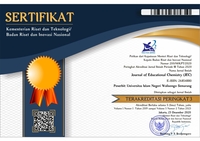KIMI.AR Application for Easier and Interactive Chemistry Learning
DOI:
https://doi.org/10.21580/jec.2023.5.2.16077Keywords:
augmented relay, chemistry learning, mobile applicationAbstract
Chemistry is a crucial subject since it covers the structure and makeup of the world around us. However, chemistry is frequently cited as a subject that students dislike. Most secondary school pupils believe that chemistry is difficult, uninteresting, and unimportant. Therefore, an improvement in learning technic is needed. An application called KIMI.AR was created in this research. KIMI.AR is a learning media in the form of a mobile-based augmented reality application regarding elements and the formation of chemical reactions that are expected to solve high school students' problems in the chemistry learning process. What makes the KIMI.AR application better than other chemistry learning applications is the focus on the displayed material according to the user's level and displaying descriptions in addition to 3D visualization that students can access through their respective Android devices. So, through the KIMI.AR application, learning chemistry becomes easier and more interesting.Downloads
References
Ali, T. 2012. A Case Study of the Common Difficulties Experienced by High School Students in Chemistry Classroom in Gilgit-Baltistan (Pakistan). SAGE Open, 2(2), 2158244012447299. https://doi.org/10.1177/2158244012447299
Broman, K., Ekborg, M., & Johnels, D. 2011. Chemistry in crisis? Perspectives on teaching and learning chemistry in Swedish upper secondary schools. Nordic Studies in Science Education, 7, 43–60. https://doi.org/10.5617/nordina.245
Cai, S., Wang, X., & Chiang, F.-K. 2014. A Case Study of Augmented Reality Simulation System Application in a Chemistry Course. Computers in Human Behavior, 37, 31–40. https://doi.org/10.1016/j.chb.2014.04.018
Cardellini, L. 2012. Chemistry: Why the Subject is Difficult?. Educación Química, 23, 305–310. https://doi.org/10.1016/S0187-893X(17)30158-1
Hofstein, A., Eilks, I., & Bybee, R. 2011. Societal Issues and Their Importance for Contemporary Science Education — A Pedagogical Justification and the State-of-the-Art in Israel, Germany, and the USA. International Journal of Science and Mathematics Education, 9(6), 1459–1483. https://doi.org/10.1007/s10763-010-9273-9
Irwansyah, F. S., Yusuf, Y. M., Farida, I., & Ramdhani, M. A. 2018. Augmented Reality (AR) Technology on The Android Operating System in Chemistry Learning. IOP Conference Series: Materials Science and Engineering, 288(1), 012068. https://doi.org/10.1088/1757-899X/288/1/012068
Lase, D. 2019. Education and Industrial Revolution 4.0. Jurnal Handayani, 10(1), 48–62. https://doi.org/10.24114/jh.v10i1.14138
Lawrie, G. A., Schultz, M., Bailey, C. H., Al Mamun, Md. A., Micallef, A. S., Williams, M., & Wright, A. H. 2016. Development of Scaffolded Online Modules To Support Self-Regulated Learning in Chemistry Concepts. In Technology and Assessment Strategies for Improving Student Learning in Chemistry. American Chemical Society, 1235, 1-21. https://doi.org/10.1021/bk-2016-1235.ch001
Macariu, C., Iftene, A., & Gîfu, D. 2020. Learn Chemistry with Augmented Reality. Procedia Computer Science, 176, 2133–2142. https://doi.org/10.1016/j.procs.2020.09.250
Mazzuco, A., Krassmann, A. L., Reategui, E., & Gomes, R. S. 2022. A Systematic Review of Augmented Reality in Chemistry Education. Review of Education, 10(1), e3325. https://doi.org/10.1002/rev3.3325
Nechypurenko, P. P., Stoliarenko, V. G., Starova, T. V., Selivanova, T. V., Markova, O. M., Modlo, Y. O., & Shmeltser, E. O. 2020. Development and Implementation of Educational Resources in Chemistry with Elements of Augmented Reality. Augmented Reality in Education: Proceedings of the 2nd International Workshop, 156-167. https://doi.org/10.31812/123456789/3751
Saini, M., Sengupta, E., Singh, M., Singh, H., & Singh, J. 2023. Sustainable Development Goal for Quality Education (SDG 4): A study on SDG 4 to Extract the Pattern of Association Among the Indicators of SDG 4 Employing a Genetic Algorithm. Education and Information Technologies, 28(2), 2031–2069. https://doi.org/10.1007/s10639-022-11265-4
Sausan, I., Saputro, S., & Indriyanti, N. Y. 2018. Chemistry for Beginners: What Makes Good and Bad Impression. Proceedings of the Mathematics, Informatics, Science, and Education International Conference (MISEIC 2018). Mathematics, Informatics, Science, and Education International Conference (MISEIC 2018), Surabaya, Indonesia. https://doi.org/10.2991/miseic-18.2018.1
Downloads
Published
How to Cite
Issue
Section
License
The copyright of the received article shall be assigned to the journal as the publisher of the journal. The intended copyright includes the right to publish the article in various forms (including reprints). The journal maintains the publishing rights to the published articles.
Authors are permitted to disseminate published articles by sharing the link/DOI of the article at the journal. Authors are allowed to use their articles for any legal purposes deemed necessary without written permission from the journal with an acknowledgment of initial publication to this journal.

This work is licensed under a Creative Commons Attribution-NonCommercial-ShareAlike 4.0 International License.


